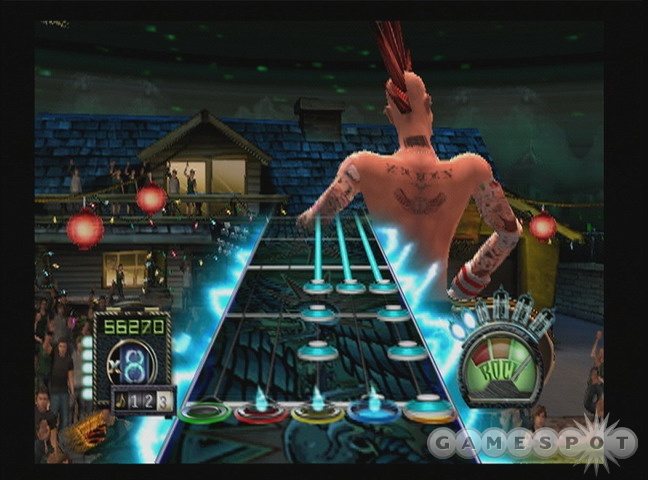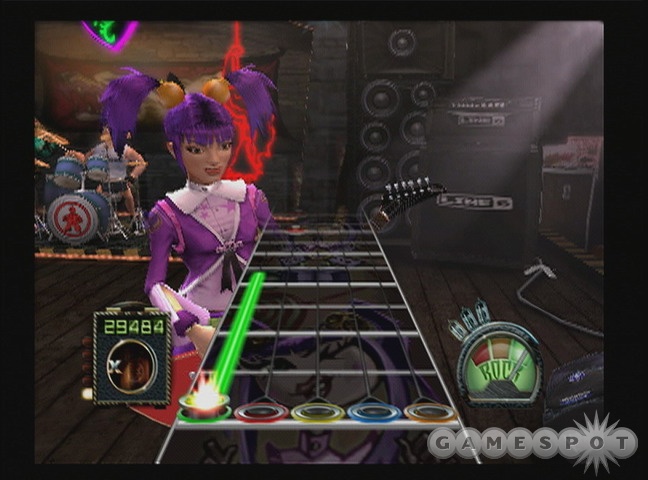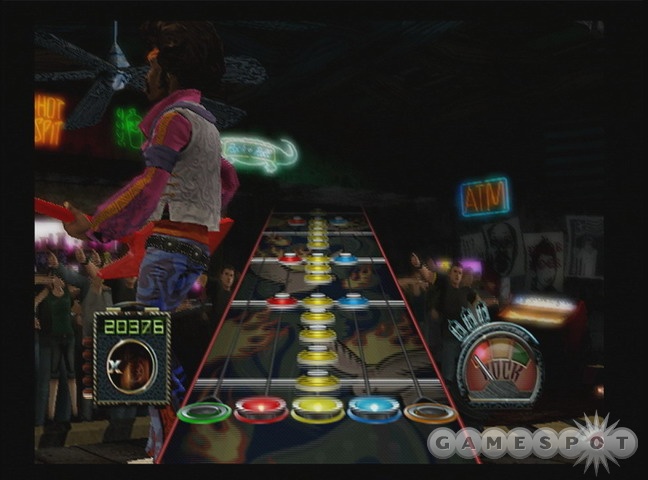You wouldn't have been wrong to come into Guitar Hero III: Legends of Rock with some sense of trepidation. With original Guitar Hero developer Harmonix off the project and Tony Hawk creators Neversoft now on board, it would be fair to wonder if anything that made the wildly popular rhythm game franchise so awesome would be lost in the shuffle. The good news is that Guitar Hero III is Guitar Hero through and through. The core gameplay that fans love hasn't changed outside of some basic tweaks, and the long and varied tracklist is the best of any game in the series to date. If there are any chinks in the armor of this sequel, it's that some of the newer mode additions and a few odd design decisions do more to get in the way of the fun than anything else. Likewise, the extreme difficulty of some of the game's more severe songs might end up turning off newer players. Those issues aside, it's hard to argue with what Guitar Hero III offers from a content perspective, especially if you're a longtime fan of the franchise.

We won't spend a great deal of time trying to educate you on the ways of Guitar Hero if you've never played one of these games before. The quick and dirty explanation is that you have a guitar controller with five fret buttons and a strummer. Notes appear on the screen, you hit the matching buttons, and rock is made. In Guitar Hero III, you'll be making the rock with one of the best soundtracks to be found in any rhythm game. The soundtrack spans multiple eras and genres. Classic rock is represented with songs such as Santana's "Black Magic Woman," the Rolling Stones' "Paint it Black," and ZZ Top's "La Grange." Alternative rock from the '90s is present in a big way with tracks such as The Smashing Pumpkins' "Cherub Rock," Red Hot Chili Peppers' "Suck My Kiss" and Pearl Jam's "Evenflow" on-hand. Classic punk fans will dig being able to play the Dead Kennedys' "Holiday in Cambodia," Social Distortion's "Story of My Life," and the Sex Pistols' "Anarchy in the UK." Modern rock hits such as Bloc Party's "Helicopter," The Killers' "When You Were Young" and Queens of the Stone Age's "3's and 7's" are also available. And for all the metalheads, you get major classics such as Slayer's "Raining Blood," Iron Maiden's "Number of the Beast" and Metallica's "One." It's an all-around fantastic list with only a few blemishes here and there. It's easily a much higher ratio of quality over crap than what Guitar Hero II had.
It's worth noting the number of original tracks added into this year's game. Well over half of the songs in Guitar Hero III are the original songs by the artists, as opposed to covers created for the purposes of the game. A couple of bands, including the Sex Pistols and early '90s funk-metal outfit Living Colour, actually went into the studio and rerecorded their songs for the game, which is pretty cool. The one downside to having so many master tracks in this game is that it does make the songs that are still covers stick out all the more. It doesn't help that the general quality of the covers has also been downgraded a good bit since the last sequel. The woman covering Pat Benatar's "Hit Me With Your Best Shot" doesn't really sound anything like the '80s songstress; the version of Black Sabbath's "Paranoid" in the game features a uniformly unimpressive Ozzy Osbourne impersonator; and the entire cover of "Holiday in Cambodia" has been pretty badly butchered with some weird structuring changes, badly edited lyrics, and a guy who sounds more like someone trying to parody Jello Biafra than anyone remotely authentic. Of course, the guitar parts in these covers don't suffer much and in fact do a fine job of emulating the real-life songs. It's just the surrounding pieces that rob the tracks of authenticity.
Of note as well is the fact that Guitar Hero II's focus on extreme shredding over simple yet memorable riffs is even more intense in this sequel. The easy and medium difficulties are as good a starting point as they've ever been (though even they are a smidge more difficult than previous installments), but the curve definitely takes a steep incline when you bump up to hard and expert. The jump in expertise required for each setting is far greater than ever before, and at times it comes across as just too much. As awesome as songs like "One" and "Raining Blood" are, they're so intense that it's unlikely that anyone who didn't get all the way through expert in Guitar Hero II will have a blessed clue what to do with these songs. And then there's that pesky song from extreme power metal group DragonForce, "Through the Fire and Flames." It sounds a little bit like a Dungeons & Dragons dork singing over a tape of the Contra soundtrack that's been thrown in a blender and set to "liquefy," and it is so excruciatingly, arthritis-inflictingly difficult that you'll be thanking your lucky stars it's a bonus song and not something you're required to complete to advance. Regardless, there are enough songs that do require completion that aren't terribly far behind in difficulty level that it might just be enough to scare some people off from finishing expert altogether. There's an old adage along the lines of "You win more friends with accessible fun than you do by breaking people's fingers with a fake guitar." Or something like that. Whatever. The point is that Guitar Hero III feels decidedly geared toward the hardcore Guitar Hero fan, and less for the newcomer.
Painful difficulty aside, the game is still lots and lots of fun. The core gameplay hasn't been altered much, save for a few minor adjustments here and there. Hammer-ons and pull-offs, the techniques used to hit crazy streaks of tightly packed single notes, are now easier than ever before (possibly to offset some of the extreme extremeness of the harder songs), and the notes that can be hammered on or pulled off now glow brightly to signify as such. While playing, you'll notice that the game also keeps track of your note streaks both with a counter and with periodic exclamatory text messages on the screen that notify you when you've hit certain streak milestones. There are also some changes to the way your star-power meter is displayed, as well as your score tracker, though these are mostly just aesthetic changes.

You progress through Guitar Hero III much as you would any of the previous games. The career mode uses the same tiered-unlocking system as its predecessors, with encores at the end of each tier. One wrinkle to this year's mode is the addition of animated cutscenes that sketch a minimal story about your band's meteoric rise and eventual fall (literally) into hell. It's not much of a tale, but there are a few moments of amusement here and there. One particularly interesting addition to this year's game is a co-op career mode. This works much like the single-player career mode, but you can play through with a friend who you can divvy up either lead or rhythm guitar/bass duties with. Co-op play hasn't changed much since last year's game, but this new career progression is a neat idea.
Unfortunately, it's a neat idea that's overly restrictive in practice. For one thing, there are six songs you can unlock only in co-op career, which means that if you don't have a buddy with a second guitar that can come over and spend an afternoon playing, you won't get those songs (at least until someone eventually digs up the "unlock all songs" code for the game). Also, no version of the game ships with a co-op quick-play option. The only way to play cooperatively on a single console is to play in the co-op career mode, and you have to unlock six tiers' worth of songs before you unlock all the available songs. Interestingly enough, there is a launch-day patch for the Xbox 360 version of the game that adds a co-op quick-play option. However, if your 360 isn't connected to Xbox Live, or you happen to buy any other version of the game, you're out of luck at the moment.
Elsewhere in the multiplayer arena, the face-off and pro face-off modes from the previous Guitar Hero games return, and they're still generally excellent. However, the one new addition is anything but. Titled battle mode, this mode replaces the star-power mechanic with Mario Kart-style weapons. If you hit a specific note string, you'll gain a weapon you can launch at your opponent by tilting the guitar. Weapons include broken strings, jacked-up whammy bars, amplifier overloads (which cause notes to appear and disappear randomly), and a reversal of the notes to lefty flip (and vice versa). On paper, this mode seems as if it could be amusing, but in practice it's just dumb. Most of the battle-mode matches we played were over in 30 seconds or less because one player simply couldn't recover quickly enough to get a weapon and fire back. It's basically a situation where whoever gets a weapon first wins most of the time. Even when matches do go on for a bit longer, they aren't really much fun anyway.
Battle mode actually finds its way into the career mode in the form of boss battles. Activision went out and licensed a pair of notable guitar players: Guns N' Roses/Velvet Revolver legend Slash, and Rage Against the Machine/Audioslave shredder Tom Morello. At the end of a couple of tiers in the career mode, you go head-to-head against these guys in original guitar tracks that they themselves recorded, during which time battle-mode rules apply. Nevertheless, the same balancing issue pops up. Most of the boss battles can be bested pretty quickly if you get a couple of weapons in a row. The last boss battle has you playing a heavy-metal cover of "The Devil Went Down to Georgia" against a fairly obvious opponent, and that fight is considerably tougher than the other two, but it's also the last boss of the game, so it would kind of have to be. The boss-battle mechanic just feels tacked on. With only three battles out of eight tiers in the game, and only two of them against real guitarists, it feels like a quickly tossed-together mechanic that, again, just isn't that much fun.
Quite a bit more enjoyable than any battle modes or boss battles is the addition of online play for the Xbox 360, PlayStation 3, and Wii versions of the game. Guitar Hero has never been online before, and the ability to go online and take on the top axe grinders in the world is a huge bonus. Online options include all the offline gameplay modes. Ranked matches let you play face-off, pro face-off, and battle modes, and player matches let you do all of that plus the co-op songs. Sadly, you can't do the co-op career mode online, but at least your friends can strap on a bass and play online. There are some key differences between the three online versions of the game. The PlayStation 3 version doesn't include any manner of friends-list support, which means you can play only against random players online. The Wii version lets you play both random players and friends, though the friend options are limited to game-specific friend codes. The Xbox 360 version probably has the greatest ease of use online, with all the standard Xbox Live accoutrements, as well as easy access to downloadable songs (though, depending on your opinion of the pricing of said songs, that might be a blessing or a curse). The PS3 version should also include downloadable songs through the PlayStation Network store; unfortunately, the Wii version isn't set up for any kind of content downloads. The good news about all three versions is that they perform wonderfully online. Lag never got in the way of the gameplay experience in any matches we played.
While on the subject of differences between versions, it's worth noting that each version of Guitar Hero III comes with its own guitar bundle. Xbox 360 owners may not necessarily want a bundle if they already own the Guitar Hero II guitar, but III comes with a new wireless guitar that features a detachable neck, a much better whammy bar, better strap design, and more responsive buttons. If you weren't satisfied with the GH II guitar, this is a good upgrade and potentially worth the $100 asking price for the bundle. PS3 and Wii owners have never had a GH game before, so you will need to buy a bundle to play with the guitar. The PS3 version costs the same as the 360 one, and the guitar is functionally identical as well, save for a small dongle that has to be plugged into the PS3's USB port to make the wireless action work. The Wii version costs $90, and has the most unique guitar of all of the available versions, in that it features a connector for the Wii Remote. The remote fits snugly into a port on the back of the guitar, and the remote essentially takes over as the guitar's tilt sensor. It also does a few unique things, such as buzzing slightly when you engage star power, and playing all the missed note sounds through the Wii Remote speaker. PS2 owners also get a bundle, though unless you really, really want a wireless guitar, there's not much reason to go that route here. The new guitar's buttons aren't much better than the previous PS2 guitars, and the sync process for the wireless controller is kind of clunky. It's a nice-looking guitar, but it's not quite worth paying $90 for.
The change in developers has also resulted in a slight change in visual style in Guitar Hero III. The look of all the various characters and environments has changed noticeably, and everything has been given a more defined and exaggerated look. It might be slightly jarring to those accustomed to the standard Guitar Hero visuals, but once you get used to it, you'll find the game to be pretty sharp-looking. The guitarist characters look excellent, and even the secondary band players look more detailed than ever before (though considering how dog-ugly the singer is, maybe he could have stood to have a little less detail). The PS2 and Wii versions look about on par with one another, and look maybe slightly better than the last couple of PS2 Guitar Hero games. The Xbox 360 and PS3 versions are considerably better-looking, even over Guitar Hero II on the 360. However, the one thing that does get in the way with these versions is occasional bouts of frame-rate slowdown, specifically when engaging star power while lots of notes are onscreen. This chugging is really distracting and can occasionally throw you off while you're playing. Rhythm games, perhaps more than any other genre, really need to not slow down, and it's disappointing that this one does.

It's also disappointing that Activision has finally decided to corporate up the Guitar Hero experience with a fair amount of lame product placement and dynamic in-game advertising. It's one thing to get branded guitars and get Guitar Center to sponsor your in-game shop-- it's quite another to have several of the game's environments feature billboards that display ads dynamically, and logos for Pontiac and Axe Body Spray that pop up all over the place. It even goes so far as to have Axe-sponsored guitars you can buy in-game, and Axe-sponsored go-go dancers prancing about the stage while you play. Gross.
An abundance of advertising, a few visual issues, some overly restrictive design decisions, weak new modes, and a major upping of the difficulty level might seem like a lot of potential hindrances for a game to overcome, and yet none of these problems are big enough to rob Guitar Hero III of the same brand of addictive fun that made the previous entries in the franchise so engaging. Certainly the fantastic track list goes a long way toward that end, but the gameplay is really what sells it. Sure, the difficulty can be vexing, but the game never loses that sense of "just one more song" addictiveness, even at the height of its challenge level. Once you start playing, you'll be hooked for hours at a time, both online and off. It might ultimately just be more Guitar Hero, but that's hardly a bad thing--in fact, it's a great thing.
